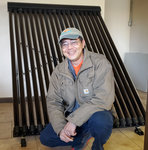


Editor’s Note:The Chronicle is working to assist local businesses suffering from the effects of the COVID-19 virus spread and associated government orders to close or limit commerce. There will be a feature on a local business in each edition of The Chronicle and at chronline.com moving forward. To be considered, email reporter Eric Trent at etrent@chronline.com. Additionally, The Chronicle will continue to offer its coverage of the coronavirus and its effects across the community, state and nation free outside of our paywall at chronline.com.
Tucked away off Kresky Avenue is a tan sheet-metal building that one might not even notice when driving by. A closer look reveals a small, white trailer that reads “Silk Road Solar” and a sign on the storefront with the words “Silk Road Environmental.” That might bring up even more questions.
Inside is Ray Lam’s workshop and warehouse for his solar hot water heater company he created 12 years ago. Lam, a licensed environmental engineer, got his start in engineering while tinkering away on his family’s farm in Richmond, British Columbia. After earning a bachelor’s degree in applied science from the University of British Columbia, he began working as the environmental manager for the Boise Cascade paper mill in Boise, Idaho.
“Then I decided I wanted to continue improving the environment in a way that was personally satisfying,” Lam said.
So Lam created Silk Road Environmental and began looking for ways that people could reduce energy consumption. He’s also a chemical engineer and helped write the professional engineering exam (Principles and Practice of Engineering).
His company specializes in solar hot water heaters. They do not produce any electricity, only hot water, which can be used for heating baths, showers, radiant flooring and can be modified to blow hot air through a house radiator.
The solar hot water heaters use custom solar hot water tubes that were designed by Lam to produce heat more efficiently than traditional photovoltaic solar panels. The solar water heaters, which range in size from three tubes all the way up to 20 or more, are glass with sealed copper piping, which conducts the heat. They can be attached to roofs and on walls just like traditional solar panels and work well even in winter with reduced sunlight.
“The big difference between solar hot water and solar electric is we don’t produce electricity,” Lam said. “It only reduces energy demand.”
The company also uses phase change material, a substance that releases and absorbs energy at phase transitions to provide heating and cooling. Lam engineered a palm-sized octagon ball with a plastic shell containing wax. The balls are dropped in Lam’s custom hot water tanks and when the water reaches 165 degrees fahrenheit, all the additional energy goes towards melting the wax inside the ball. When the hot water is used, the water drops to 163 degrees and the wax resolidifies and dumps all the heat used for melting back into the water. It allows the 300-gallon tanks to produce 700 gallons of hot water.
It’s an eco-friendly alternative to using electricity, which reduces energy demand, and Lam is selling his units to everyone from private households to apartment buildings and housing divisions.
Silk Road Environmental is the largest solar hot water heater producer in the Pacific Northwest, and most of its customers are in the greater Seattle area and the Olympic Peninsula, with a few customers in Lewis County. It has the largest installs in Washington, Idaho and Oregon, but performs installations all over the U.S.
Hamilton Cellars in Benton City, Washington, is the first zero-energy winery in the state, using Silk Road Environmental’s solar hot water systems. One townhouse complex in Prescott, Washington uses 179 of Lam’s panels to create the largest solar hot water array in the state. Lam also flew on a state helicopter to install solar hot water heaters at the Camp Muir shelters on Mount Rainier.
Silk Road Environmental is not only an installer but also a manufacturer. It either creates all its own materials or has them custom-made by companies ranging from Vancouver, Washington to China. And the products are ever-evolving and improving. Lam travels to China every year and re-designs his products to make them more efficient.
Lam also sells the parts for people or businesses to install it themselves, which is fairly straightforward, he said.
A typical installed unit is much cheaper than traditional solar panels, running about $3,200. If a person bought the parts themselves, it would cost about $1,700. Owners of new residential and commercial solar can deduct 22 percent of the cost of the system from their taxes as well.
Lam estimates that a typical residential customer can make their money back on their investment through solar tax credits in about five years.
“How long does it take to make your money back on your hot water heater now? Never,” Lam said. “Most things in a house have no return on investment.”
He’s also working on a bevy of new creations. He has a prototype barbecue kit, which looks like a suitcase and folds out into a solar barbecuer with solar panels and an insert that can cook meat and a glass piece to boil coffee. He also has a chair gifted to him from the Spokane Tribe of Indians made from beetle-damaged wood. He plans to use it as a prototype to route the back of the chair with mini-split copper piping to heat the seat.
“We create industries that currently don’t exist,” Lam said. “It’s not making people go out of business. Every year we make new things that didn’t exist before. We’re a weird little company in a weird little location. Most people don’t know what the heck we do.”
•••
Reporter Eric Trent can be reached at etrent@chronline.com. Visit chronline.com/business for more coverage of local businesses.